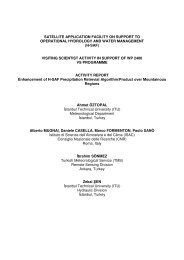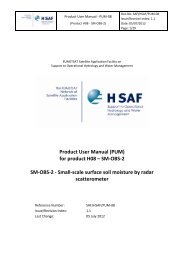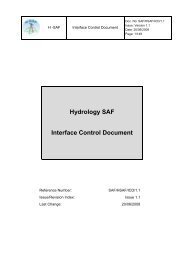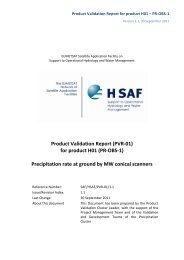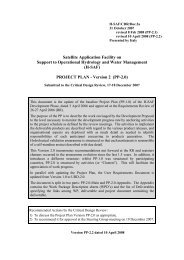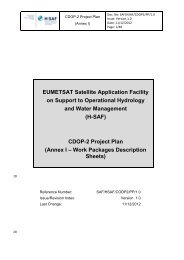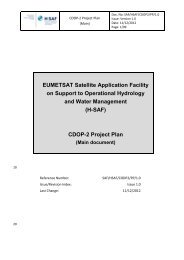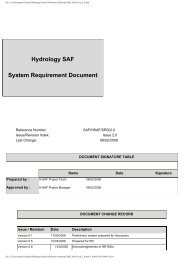H-SAF Product Validation Report (PVR) PR-OBS-3
H-SAF Product Validation Report (PVR) PR-OBS-3
H-SAF Product Validation Report (PVR) PR-OBS-3
Create successful ePaper yourself
Turn your PDF publications into a flip-book with our unique Google optimized e-Paper software.
<strong>Product</strong>s <strong>Validation</strong> <strong>Report</strong>, 30 May 2010 - <strong>PVR</strong>-03 (<strong>Product</strong> <strong>PR</strong>-<strong>OBS</strong>-3) Page 28<br />
be calculated to quantify the similarity of two images. In case of two classes of precipitation the<br />
suggested parameters are: FAR, POD, BIAS, ETS and HSS. In case of more than two classes the<br />
useful parameters are: HSS and correlation coefficient.<br />
For a reliable validation plan an ensemble of cases (each of them consisting in estimated and “truth‟<br />
maps) have to be considered. The larger the ensemble is the more reliable the validation is. The visual<br />
comparison for several pairs of images become not easy and therefore only the 2 and 3 procedures are<br />
suggested. However it does worth to mention that there are two ways to carry out those procedures: a)<br />
all the pixels from the ensemble of cases are considered together. We obtain an ensemble of pixels of<br />
satellite precipitation estimation and an ensemble of pixels of precipitation “truth”. The two ensemble<br />
are compared by calculating the previously indicated parameters. b) for each case the comparison is<br />
carried out by calculating the above statistics parameters. The average values of those statistics<br />
parameters are calculated over the ensemble of cases.<br />
It is also suggested to carry out the validation for two different areas: sea and land. This because the<br />
precipitation “truth” over the land is mainly based on raingauges whereas for the sea only radar<br />
estimation are available. A further distinction will be made considering orography, by using a digital<br />
elevation model (e.g. GTOPO30 by the U.S. Geological Survey).<br />
<strong>Validation</strong>: complete plan<br />
The precipitation “truth” data set is built for a complete year at 15 minutes of time resolution.<br />
Instantaneous rain validation (MW algorithm): all the polar satellite overpasses over Italy during the<br />
considered year can be collected and used to generate the corresponding MW-based precipitation<br />
estimation. All of them can be validated. MW+IR algorithm: for each time of the day and for each<br />
day of the year it is possible to validate the MW+IR-based precipitation estimation. In this case the<br />
variability of performance along the day and along the year can be assessed. Moreover the<br />
degradation of MW+IR performance far from the MW overpass can be evaluated.<br />
Cumulated rain validation (MW+IR algorithm): cumulated estimated rain at 3, 6, 12 and 24 hours<br />
intervals can be validated by using the corresponding cumulated “truth” rain. The variability of<br />
performance along the year can be assessed as well.<br />
<strong>Validation</strong>: minimal plan<br />
The precipitation “truth” data set is built for summer and winter at around 12 and 24 UTC.<br />
Instantaneous rain validation (MW algorithm): all the polar satellite overpasses over Italy in that<br />
period can be collected and used to generate the corresponding MW-based precipitation estimation.<br />
All of them can be validated.<br />
Instantaneous rain validation (MW+IR algorithm): for 12 and 24 UTC times and for each day of<br />
summer and winter it is possible to validate the MW+IR-based precipitation estimation. In this case<br />
it is expected to get information about the maximum variability of performance.<br />
Cumulated rain validation (MW+IR algorithm): cumulated estimated rain at 3,6,12 and 24 hours<br />
intervals for summer and winter can be validated by using the corresponding cumulated “truth” rain.<br />
<strong>Validation</strong>: specific plan<br />
The precipitation “truth” data set is built for particular region of Italy and/or for particular month and/or<br />
particular time of the day.<br />
Instantaneous rain validation (MW algorithm): all the polar satellite overpasses over that region and<br />
in that period can be collected and used to generate the corresponding MW-based precipitation<br />
estimation. All of them can be validated. MW+IR algorithm: for that region and that period it is<br />
possible to validate the MW+IR-based precipitation estimation.<br />
Cumulated rain validation (MW+IR algorithm): cumulated estimated rain at 3, 6, 12 and 24 hours<br />
intervals for that region and that period can be validated by using the corresponding cumulated<br />
“truth” rain.




